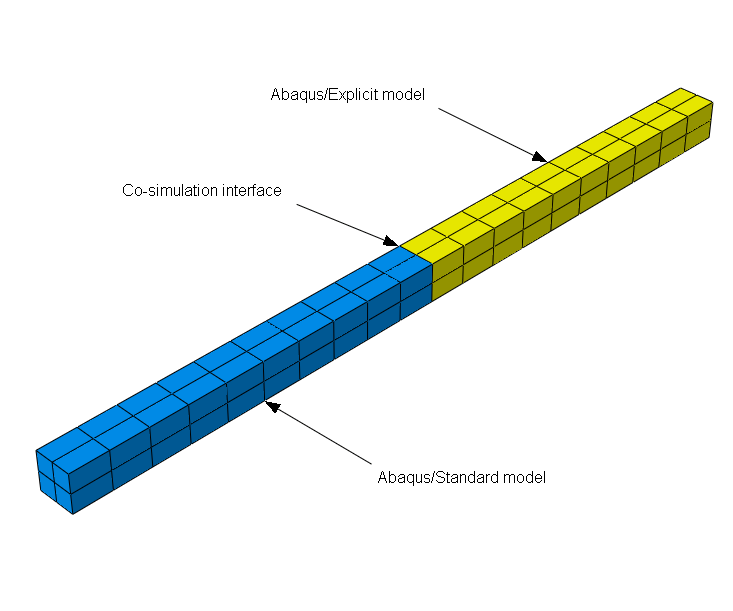
Products: Abaqus/Standard Abaqus/Explicit
The tests in this section verify the co-simulation interaction of Abaqus/Standard and Abaqus/Explicit when the two analysis products address complementary domains of a model. Results obtained from an Abaqus/Explicit simulation of the same model are used as a reference solution.
The following sections describe verification problems for:
lockstep co-simulation of Abaqus/Explicit with Abaqus/Standard nonlinear dynamic procedures;
subcycling co-simulation of Abaqus/Explicit with Abaqus/Standard nonlinear dynamic procedures;
subcycling co-simulation of Abaqus/Explicit with Abaqus/Standard nonlinear quasi-static procedures; and
various cases of modeling techniques and model attributes applied at the co-simulation interface between the Abaqus/Explicit and Abaqus/Standard jobs.

The fidelity and numerical stability of results obtained using a lockstep Abaqus/Standard to Abaqus/Explicit co-simulation for a model undergoing dynamic large-deformation motion.
The problem is a simple beam subjected to an excitation force at the end (see Figure 3.17.2–1).
Figure 3.17.2–1 Continuum element co-simulation model configuration. The configuration of the beam verification problems lies on the centerline of the models shown in this figure. Shell elements, when used, lie on the outside of the models shown.

The model consists of Abaqus/Standard and Abaqus/Explicit components of a beam of length 20, width 1, and height 1.
Mesh:
A regular brick mesh is used for the continuum and shell element models.
Material:A linear elastic material definition is used.
Boundary conditions:
The Abaqus/Standard portion of the beam is fully embedded at its end.
Loading:
The Abaqus/Explicit portion of the beam has a load applied transverse to the beam axis.
Co-simulation definition:
The PROGRAM=ABAQUS option is used in the *CO-SIMULATION definition for each model. Each model uses TIME INCREMENTATION=LOCKSTEP on the *CO-SIMULATION CONTROLS option.

When using the TIME INCREMENTATION=LOCKSTEP option, Abaqus/Standard and Abaqus/Explicit will advance their respective solution using the same time incrementation.
In each case there is generally good agreement between the Abaqus/Standard to Abaqus/Explicit co-simulation results and the Abaqus/Explicit results.
B31 Abaqus/Standard analysis.
B31 Abaqus/Explicit analysis.
B31 Abaqus/Explicit reference analysis.
C3D8I Abaqus/Standard analysis.
C3D8I Abaqus/Explicit analysis.
C3D8I Abaqus/Explicit reference analysis.
B31, C3D8I, S4R Abaqus/Standard analysis.
B31, C3D8I, S4R Abaqus/Explicit analysis.
B31, C3D8I, S4R Abaqus/Explicit reference analysis.
T3D2 Abaqus/Standard analysis.
T3D2 Abaqus/Explicit analysis.
T3D2 Abaqus/Explicit reference analysis.
C3D4 Abaqus/Standard analysis.
C3D8 Abaqus/Explicit analysis.
C3D8 Abaqus/Standard analysis.
C3D4 Abaqus/Explicit analysis.

The fidelity and numerical stability of results obtained using a subcycling Abaqus/Standard to Abaqus/Explicit co-simulation for a model undergoing dynamic large-deformation motion.
The problem is a simple beam subjected to severe excitation force (see Figure 3.17.2–1).
Model:The model consists of Abaqus/Standard and Abaqus/Explicit components of a beam of length 20, width 1, and height 1.
Mesh:
A regular brick mesh is used for the continuum and shell element models.
Material:A linear elastic material definition is used.
Boundary conditions:
The Abaqus/Standard portion of the beam is fully embedded at its end.
Loading:
The Abaqus/Explicit portion of the beam has a load applied transverse to the beam axis.
Co-simulation definition:
The PROGRAM=ABAQUS option is used in the *CO-SIMULATION definition for each model. Each model uses TIME INCREMENTATION=SUBCYCLE on the *CO-SIMULATION CONTROLS option.

When using the TIME INCREMENTATION=SUBCYCLE option, Abaqus/Standard and Abaqus/Explicit will advance their respective solutions using time incrementation appropriate to their solution.
In each case there is generally good agreement between the Abaqus/Standard to Abaqus/Explicit co-simulation results and the Abaqus/Explicit results.
B31 Abaqus/Standard analysis.
B31 Abaqus/Explicit analysis.
B31 Abaqus/Explicit reference analysis.
C3D8I Abaqus/Standard analysis.
C3D8I Abaqus/Explicit analysis.
C3D8I Abaqus/Explicit reference analysis.
B31, C3D8I, S4R Abaqus/Standard analysis.
B31, C3D8I, S4R Abaqus/Explicit analysis.
B31, C3D8I, S4R Abaqus/Explicit reference analysis.
T3D2 Abaqus/Standard analysis.
T3D2 Abaqus/Explicit analysis.
T3D2 Abaqus/Explicit reference analysis.
C3D4 Abaqus/Standard analysis.
C3D8 Abaqus/Explicit analysis.
C3D8 Abaqus/Standard analysis.
C3D4 Abaqus/Explicit analysis.

The fidelity and numerical stability of results obtained using subcycling Abaqus/Standard quasi-static procedures to Abaqus/Explicit co-simulation for a model undergoing quasi-static deformation.
The problem is a simple beam subjected to quasi-static loading (see Figure 3.17.2–1).
Model:The model consists of Abaqus/Standard and Abaqus/Explicit components of a beam of length 20, width 1, and height 1.
Mesh:
A regular brick mesh is used for the continuum and shell element models.
Material:A linear elastic material definition is used.
Boundary conditions:
The Abaqus/Standard portion of the beam is fully embedded at the free end.
Loading:
The Abaqus/Explicit portion of the beam has a load applied transverse to the beam axis.
Co-simulation definition:
The PROGRAM=ABAQUS option is used in the *CO-SIMULATION definition for each model. Each model uses TIME INCREMENTATION=SUBCYCLE on the *CO-SIMULATION CONTROLS option.

When using the TIME INCREMENTATION=SUBCYCLE option, Abaqus/Standard and Abaqus/Explicit will advance their respective solutions using time incrementation appropriate to their solution.
In each case there is generally good agreement between the Abaqus/Standard to Abaqus/Explicit co-simulation results and the Abaqus/Explicit results.
C3D8I Abaqus/Standard analysis.
C3D8I Abaqus/Explicit analysis.
C3D8I Abaqus/Explicit reference analysis.
B31, C3D8I, S4R Abaqus/Standard analysis.
B31, C3D8I, S4R Abaqus/Explicit analysis.
B31, C3D8I, S4R Abaqus/Explicit reference analysis.
T3D2 Abaqus/Standard analysis.
T3D2 Abaqus/Explicit analysis.
T3D2 Abaqus/Explicit reference analysis.
C3D4 Abaqus/Standard analysis.
C3D8 Abaqus/Explicit analysis.
C3D8 Abaqus/Standard analysis.
C3D4 Abaqus/Explicit analysis.

The proper operation of Abaqus/Standard to Abaqus/Explicit co-simulation is confirmed for cases involving specific modeling attributes.
Each problem considered is a variation of those described in “Lockstep co-simulation of Abaqus/Standard nonlinear dynamic procedures to Abaqus/Explicit procedures.” Particular variations are listed in the input file description.
In each case the results confirm that Abaqus/Standard to Abaqus/Explicit co-simulation operates correctly with particular modeling attributes employed.
B21 Abaqus/Standard analysis.
B21 Abaqus/Explicit analysis.
C3D8I Abaqus/Standard analysis.
C3D8I Abaqus/Standard substructure generation.
C3D8I Abaqus/Explicit analysis.
C3D8I Abaqus/Standard analysis.
C3D8I Abaqus/Explicit analysis with mass scaling.
C3D4, SFM3D4R Abaqus/Standard analysis.
C3D4, SFM3D4R Abaqus/Explicit analysis.
C3D4, SFM3D4R Abaqus/Standard analysis.
C3D4, SFM3D4R Abaqus/Explicit analysis.